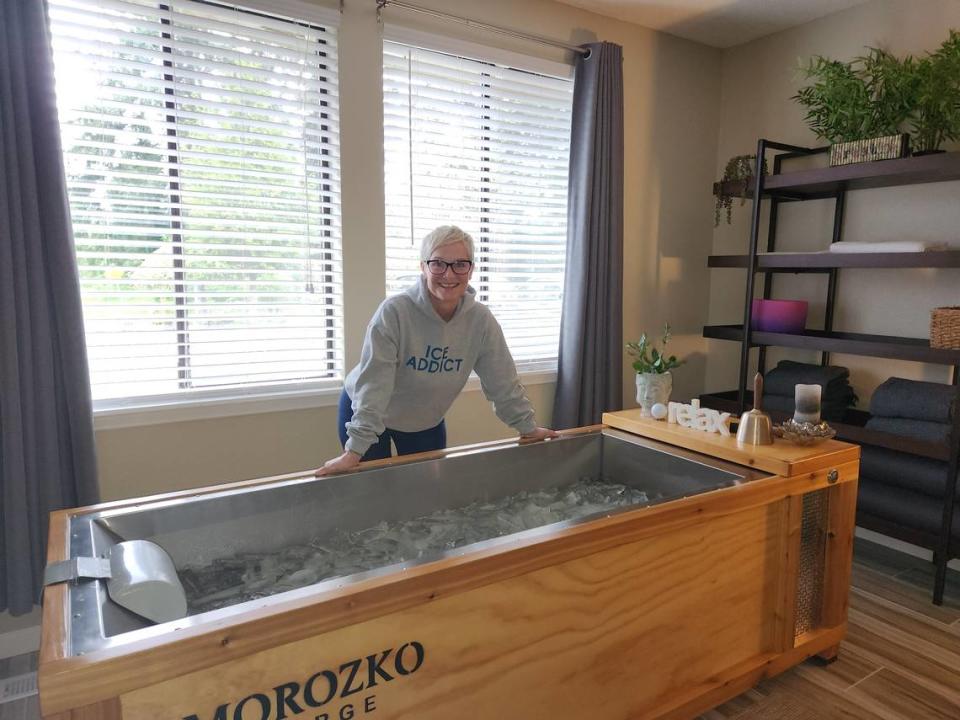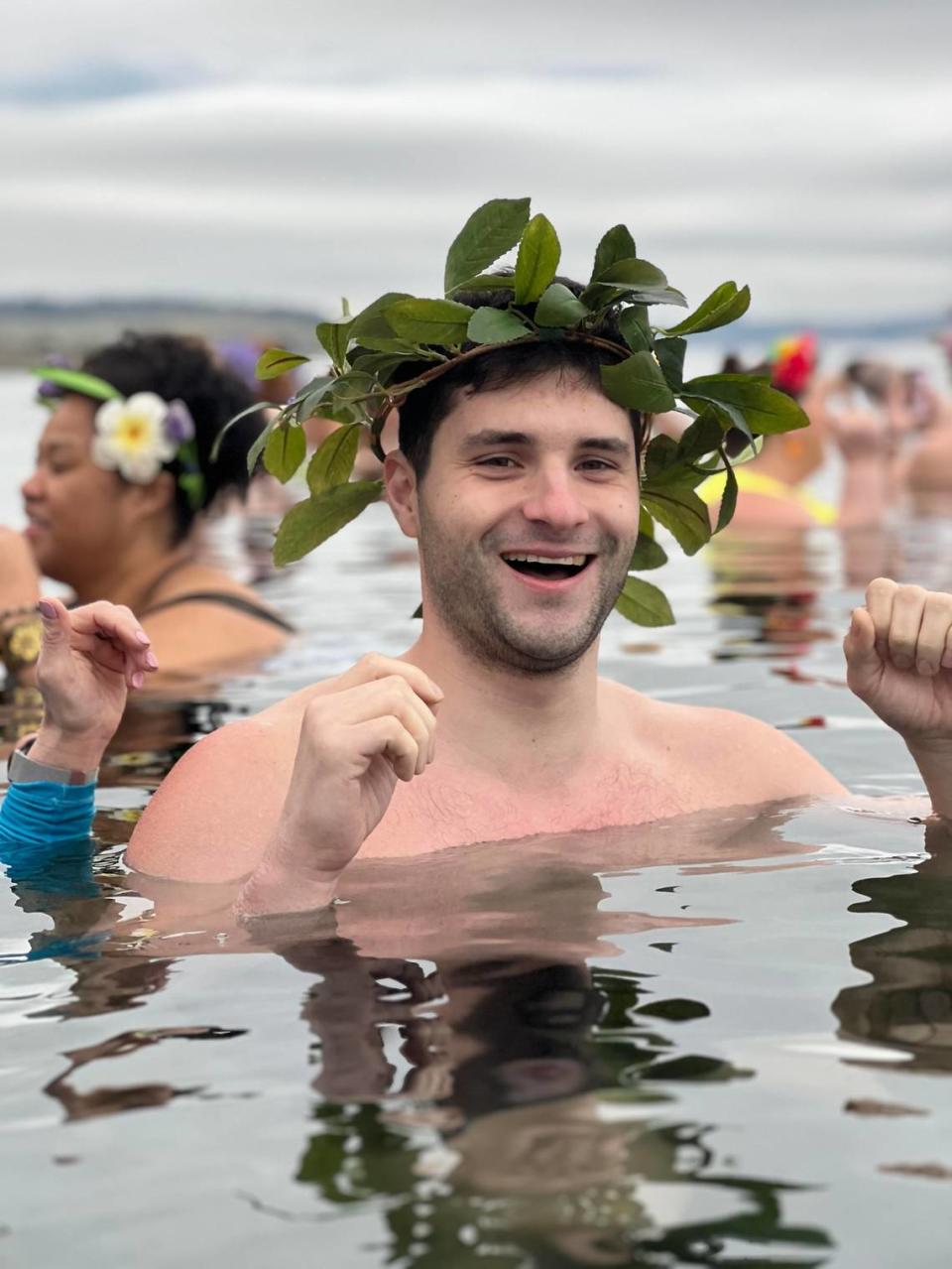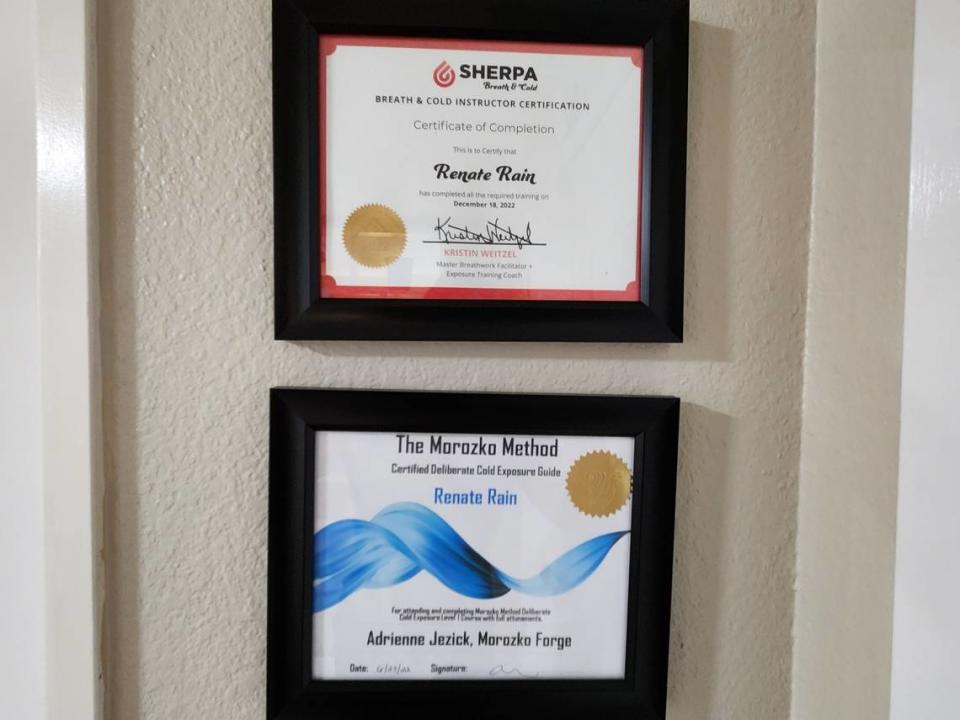Some Puget Sound residents dunk themselves in freezing water. I tried it to find out why
When I first read about cold-water treatment, the health benefits piqued my curiosity. It also felt right up my alley. As a New England native, I’m accustomed to sub-freezing temperatures and living in the snow for about half of the year. I’m naturally attune to colder environments, even more so than other New Englanders, friends and family often point out. I wear shorts year round, even as others bundle up in thick winter coats and ear muffs. Cranking the room temperature to 62 degrees is like heaven to me.
I thought, “Could a cold water plunge really test my limits?” I wanted to find out.
Late last year while reporting on a New Year’s polar plunge event in Tacoma as a newcomer to the area, I unfortunately couldn’t take the opportunity to try it myself. Then I discovered that, as a health routine, cold water plunging also promises all sorts of mind-altering, life-changing effects.
To learn more about the culture surrounding this specific practice, I joined the Puget Sound Plungers Facebook group for an early-morning plunge. I also met up with a Lakewood resident and local cold water enthusiast for an interview at her in-home cold water therapy studio.
The practice has found a small, but growing, group of devout followers in the south Puget Sound community. Here’s what I learned about what they’re up to.
Freezing for fun in Lakewood
In September 2021, Lakewood resident Renate Rain got into the Puget Sound for her first cold water plunge, a practice that involves exposing one’s entire body neck deep into near-freezing water for several minutes. Rain had been hearing about the practice online. At one point, her doctor even recommended she try it to boost her mitochondrial health and immune system.

What started as a curiosity has turned into a lifestyle for Rain. She says that routinely exposing herself to cold water has reduced her pain, anxiety and lifted her mood. Today, she soaks herself in near-freezing water daily, either in the Puget Sound at Sunnyside Beach in Steilacoom, or in her at-home cold bath. She says in the past year and a half, she has never been sick.
Rain encourages others to join her whenever she goes for a plunge.
“I thought everyone should know [about cold water plunging] because it’s the most passive, easy healing modality that I’ve ever heard of,” Rain told me during an interview in her at-home, custom furnished ice therapy studio. She installed her own ice bath, which produces its own thick slabs of ice, as well as water-proof flooring.
When Rain started spreading news about the positives of cold water therapy, she says nobody wanted to listen to her. But as she continued going down to the waters at dawn every Sunday, others started to take notice and joined in.
Rain founded the social media group Puget Sound Plungers in December 2021. She is also the founder and guide of her own cold water therapy company, Cold Confidence. In the past year-and-a-half, the community has ballooned to over 2,500 members, each interested in one thing: submerging themselves shoulders-deep under near-freezing water.
Those who follow cold water plunging as a lifestyle are a small subset of society. The science behind the practice is not well-researched because of how new the trend is. The Food and Drug Administration has even warned online users about cold water therapy and cautions them to be skeptical about the treatment’s efficacy. However, cryotherapy has been used by human civilizations for centuries. For instance, its application to treat inflammation dates back to the ancient Egyptians.
There is a limited amount of research and studies that suggest some connection between full-body cold water exposure and positive physiological outcomes. They include lowering anxiety, stress and depression, as well as an elevated mood, improved blood circulation, sleeping better, improved muscle recovery and more.
In Rain’s case, she said cold water plunging has helped her pain subside and improved her mood while reducing stress.
Cold water therapy up close
I consider myself a healthy guy. I exercise regularly, I read the nutrition facts on grocery store labels, and I prioritize getting plenty of rest. This extends to my mental health, too, as I dedicate time to doing activities that bring me joy and help me to engage in mindful practices.
Although I put effort into maintaining healthful practices, I don’t always feel as well as I think I should be feeling. I believe I can be more proactive at reducing stress, and even though I prioritize nutrition and rest, I often lack focus. I sometimes feel like I don’t have enough energy to make it through the day. I’ve wanted to do something about these issues for a while.
When I arrived to participate with the plungers at the beach – as well as Rain during a solo session in her 31-degree indoor ice bath – I expected the experiences to test my resilience and leave my toes numb. But after plunging two days in a row in completely separate environments, I got a glimpse into what the culture was all about.
I walked away having exercised not just resilience, but I also tapped into my own sense of self-empowerment and security.
On closer inspection, the community seems to be less organized around the idea of merely freezing your butt off. Instead, they rally around the warmth of being alive.
The cold water plunge experience
When I met up with Rain at 7 a.m. one cloudy Sunday in April on the coast of Sunnyside Beach in Steilacoom, the first thing I realized was that I was under-dressed. The other realization was that early risers come with their own specialty water-proof robes that they wore over their swimsuits.
I showed up with an extra pair of sneakers, swim trunks, a dry pair of shorts and towel.
When I spoke with Rain at the beach, I was surprised by the safety protocols she came equipped with regarding how to plunge properly. She told me it’s important to submerge oneself up to the neck, warned me that the body will naturally enter a fight-or-flight response to the rapid change in temperature and to hold onto a purpose for cold water plunging.
Rain also answered my questions about safety risks, such as cold shock and hypothermia. She advises newcomers to immerse themselves in water with others around them for only a couple of minutes.
Rain handed out floral headbands for members to wear to celebrate the community “May Day.” Side-by-side with the rest of the group, I waded into the calm shores of the sound. Of course, my first reaction was shock. Rain and other members, all of whom were as calm as could be, encouraged me to focus on breathing through my stomach. After a few minutes, my teeth began chattering uncontrollably, rendering my speech to drawn out mumbles and groans.
I spent around four minutes in the water. Once exiting the water, participants flash a “power pose” on the beach with feet spread wide, fists on their hips and chest and chin held high. This isn’t just for show. Rain and other members say this body position actually helps the body warm up faster.

Needless to say, I cranked my car heat to the max on my drive back to Tacoma.
The ice bath plunge
The following day, I met with Rain at her home studio in University Place. I spoke with her about her transition from first-time plunger to hardcore cold water guide. She also told me about the process of renovating her house to accommodate her plunging lifestyle.
When starting her ice bath therapy business Cold Confidence, she got a loan to purchase an ice bath from Arizona-based equipment company Morozko Forge. The tub produces its own sheet of 1.5-inch thick ice, which Rain breaks into smaller chunks. In one room down the hall, she even has a one-person sauna pod installed.

Rain invited me to take a dip into the ice bath.
Rain advised me to close my eyes and focus on deep breaths and loosen any tension I was feeling.
“You are calm. You are strong. You are safe,” Rain said. She then told me to enter the cold bath.
I was immersed in the tub for two minutes. Compared to the previous day’s plunge, the shock I experienced upon submerging myself neck deep in the 34-degree water was far more severe. The first 10 seconds were the most unbearable. Every fiber of my being was telling me I was dying. Rain assured me I was safe and that I was resilient.
After the one-minute mark, the rest of the session became more manageable. I focused on breathing through my stomach and embracing the sensory overload rather than fighting it. I pictured the thick chunks of ice and heavy water as a comforting, weighted blanket, as Rain coached me to do.
The two minutes passed and what struck me first was the feeling that for my next plunge, whenever it might be, I knew I could endure it longer. I had the sense that as I lasted longer in the tub, Rain’s meditative prompts were helping me mentally rewire how I was responding to the water. I was shifting my mindset away from, “this water is freezing me to death” to “I’m gathering life from the cold.”
Cold water plunge journey
Rain told me that oftentimes, plungers experience a high after their plunges. I can’t say I necessarily felt that – I also didn’t feel especially energized following my plunging sessions. I think this comes down to each person’s individual reaction to cold water immersion, so perhaps it would take me several consecutive plunges to start noticing any noticeable changes in my mood.
I also think dunking my head under the water would have contributed to a far more intense post-plunge endorphin release. In my past experience, I’ve felt more focused and awake after cold showers. That could be my key to getting the most out of my future plunges.
What I gathered most from the beginning of my plunging journey is how focused the local community is on increasing one’s feeling of self-empowerment and deriving joy, not panic, from essentially triggering a fight-or-flight bodily response.
To me, cold water plunging is no different than exercise – you’re teaching yourself to respond to a new activity that puts strain on the body. Each time you log a faster run time or pump out more repetitions during a workout, your training the body to adapt for the next exercise session.

 Yahoo Sports
Yahoo Sports 